The Evolution of Transport: A Journey Through Time
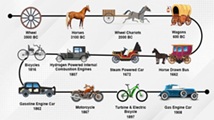 Transport, the movement of people, goods, and resources, has been fundamental to human civilization since its inception. From primitive footpaths to high-speed trains and intercontinental flights, the history of transport reflects humanity's ingenuity and adaptation to growing needs. This article explores the chronological evolution of transport, highlighting significant milestones and the transformative innovations that shaped the modern world.
Transport, the movement of people, goods, and resources, has been fundamental to human civilization since its inception. From primitive footpaths to high-speed trains and intercontinental flights, the history of transport reflects humanity's ingenuity and adaptation to growing needs. This article explores the chronological evolution of transport, highlighting significant milestones and the transformative innovations that shaped the modern world.
Early Human Transport: The Dawn of Mobility
- Walking and Carrying
-
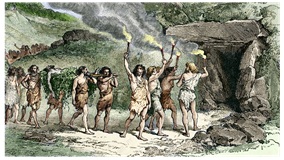 In prehistoric times, humans relied on their own physical abilities to travel and transport goods. Early trade routes formed as people walked long distances to exchange goods like tools, food, and clothing. Divided into three periods: Paleolithic (or Old Stone Age), Mesolithic (or Middle Stone Age), and Neolithic (or New Stone Age), this era is marked by the use of tools by our early human ancestors (who evolved around 300,000 B.C.) and the eventual transformation from a culture of hunting and gathering to farming and food production.
In prehistoric times, humans relied on their own physical abilities to travel and transport goods. Early trade routes formed as people walked long distances to exchange goods like tools, food, and clothing. Divided into three periods: Paleolithic (or Old Stone Age), Mesolithic (or Middle Stone Age), and Neolithic (or New Stone Age), this era is marked by the use of tools by our early human ancestors (who evolved around 300,000 B.C.) and the eventual transformation from a culture of hunting and gathering to farming and food production.
- The Role of Animals
-
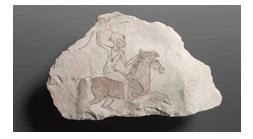 The domestication of animals like horses, camels, and donkeys revolutionized transport, enabling faster travel and heavier loads. By 3000 BCE, horses were used for riding, while oxen pulled carts and plows. How and when horses became domesticated has been disputed. The clearest evidence of early use of the horse as a means of transport is from chariot burials dated c. 2000 BC.
The domestication of animals like horses, camels, and donkeys revolutionized transport, enabling faster travel and heavier loads. By 3000 BCE, horses were used for riding, while oxen pulled carts and plows. How and when horses became domesticated has been disputed. The clearest evidence of early use of the horse as a means of transport is from chariot burials dated c. 2000 BC.
Invention of the Wheel and Ancient Transport Systems
- The Wheel (circa 3500 BCE)
-
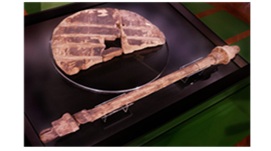 The invention of the wheel in Mesopotamia was a game-changer, allowing for the creation of carts and wagons. Wheeled vehicles facilitated trade and military operations in ancient civilizations like Sumer, Egypt, and Rome. Some recent sources either suggest that the wheel was invented independently in both Mesopotamia and Eastern Europe.
The invention of the wheel in Mesopotamia was a game-changer, allowing for the creation of carts and wagons. Wheeled vehicles facilitated trade and military operations in ancient civilizations like Sumer, Egypt, and Rome. Some recent sources either suggest that the wheel was invented independently in both Mesopotamia and Eastern Europe.
- Maritime Advancements
-
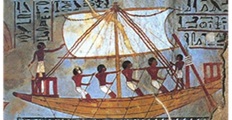 Early boats, such as dugout canoes, were used for fishing and crossing rivers. Ancient Egyptians developed sailing ships to navigate the Nile, while Phoenicians became renowned seafarers in the Mediterranean. Several ancient Egyptian solar ships and boat pits were found in many ancient Egyptian sites.
Early boats, such as dugout canoes, were used for fishing and crossing rivers. Ancient Egyptians developed sailing ships to navigate the Nile, while Phoenicians became renowned seafarers in the Mediterranean. Several ancient Egyptian solar ships and boat pits were found in many ancient Egyptian sites.
- Roads and Infrastructure
-
 The Roman Empire constructed extensive road networks to connect cities and enhance military and trade efficiency. Famous examples include the Appian Way in Italy and Persian Royal Road. The Appian Way is one of the earliest and strategically most important Roman roads of the ancient republic.
The Roman Empire constructed extensive road networks to connect cities and enhance military and trade efficiency. Famous examples include the Appian Way in Italy and Persian Royal Road. The Appian Way is one of the earliest and strategically most important Roman roads of the ancient republic.
Medieval Transport: Slow but Steady Progress
- Trade Routes Expand
-
 The Silk Road and Trans-Saharan trade routes emerged, connecting Europe, Asia, and Africa. Camel caravans were pivotal in facilitating trade across deserts. The Silk Road was a network of Eurasian trade routes active from the second century BCE until the mid-15th century.
The Silk Road and Trans-Saharan trade routes emerged, connecting Europe, Asia, and Africa. Camel caravans were pivotal in facilitating trade across deserts. The Silk Road was a network of Eurasian trade routes active from the second century BCE until the mid-15th century.
- Maritime Innovations
-
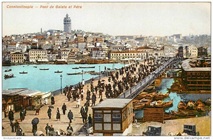 The use of larger sailing ships, such as cogs and caravels, allowed for longer sea voyages. Maritime trade flourished, especially in port cities like Venice and Constantinople. Constantinople became the capital of the Roman Empire during the reign of Constantine the Great in 330. Following the collapse of the Western Roman Empire in the late 5th century, Constantinople remained the capital of the Eastern Roman Empire ... .
The use of larger sailing ships, such as cogs and caravels, allowed for longer sea voyages. Maritime trade flourished, especially in port cities like Venice and Constantinople. Constantinople became the capital of the Roman Empire during the reign of Constantine the Great in 330. Following the collapse of the Western Roman Empire in the late 5th century, Constantinople remained the capital of the Eastern Roman Empire ... .
The Age of Exploration and Early Modern Transport (15th–18th Century)
- Navigational Breakthroughs
-
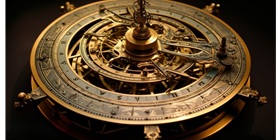 Advances in navigation, such as the compass and astrolabe, enabled explorers like Columbus, Magellan, and Vasco da Gama to undertake transoceanic voyages. European powers established global trade networks, transporting goods like spices, gold, and slaves. An astrolabe is an astronomical instrument dating to ancient times. It serves as a star chart and physical model of visible half-dome of the sky.
Advances in navigation, such as the compass and astrolabe, enabled explorers like Columbus, Magellan, and Vasco da Gama to undertake transoceanic voyages. European powers established global trade networks, transporting goods like spices, gold, and slaves. An astrolabe is an astronomical instrument dating to ancient times. It serves as a star chart and physical model of visible half-dome of the sky.
- Stagecoaches and Postal Systems
-
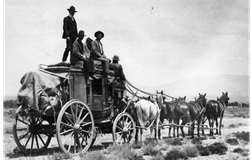 Stagecoaches became a common mode of passenger transport in Europe, providing scheduled travel along fixed routes. Organized postal systems were introduced to improve communication. A stagecoach is a four-wheeled public transport coach used to carry paying passengers and light packages on journeys long enough to need a change of horses.
Stagecoaches became a common mode of passenger transport in Europe, providing scheduled travel along fixed routes. Organized postal systems were introduced to improve communication. A stagecoach is a four-wheeled public transport coach used to carry paying passengers and light packages on journeys long enough to need a change of horses.
The Industrial Revolution: The Birth of Modern Transport
- Railways and Steam Power
-
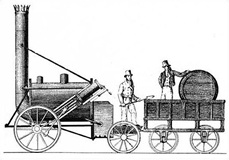 The invention of the steam engine by James Watt paved the way for railroads. George Stephenson’s locomotive, “The Rocket,” marked the beginning of the railway age in the 19th century. Railways revolutionized freight and passenger transport, connecting cities and fueling industrial growth. Rocket was designed and built by Robert Stephenson in 1829, and built at the Forth Street Works of his company in Newcastle upon Tyne.
The invention of the steam engine by James Watt paved the way for railroads. George Stephenson’s locomotive, “The Rocket,” marked the beginning of the railway age in the 19th century. Railways revolutionized freight and passenger transport, connecting cities and fueling industrial growth. Rocket was designed and built by Robert Stephenson in 1829, and built at the Forth Street Works of his company in Newcastle upon Tyne.
- Steamships
-
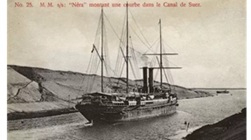 Steam-powered ships replaced sailing vessels, significantly reducing travel time across oceans. The Suez Canal (1869) and Panama Canal (1914) further enhanced maritime trade. The Suez Canal is an artificial sea-level waterway in Egypt, connecting the Mediterranean Sea to the Red Sea through the Isthmus of Suez and dividing Africa and Asia.
Steam-powered ships replaced sailing vessels, significantly reducing travel time across oceans. The Suez Canal (1869) and Panama Canal (1914) further enhanced maritime trade. The Suez Canal is an artificial sea-level waterway in Egypt, connecting the Mediterranean Sea to the Red Sea through the Isthmus of Suez and dividing Africa and Asia.
- Urban Transport
-
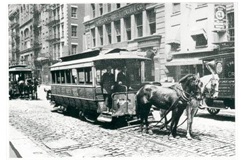 Horse-drawn carriages and trams became popular in urban areas. The bicycle, invented in the 19th century, provided an affordable means of personal transport. The history of trams, streetcars, or trolleys began in the early nineteenth century. It can be divided up into several discrete periods defined by the principal means of motive power used.
Horse-drawn carriages and trams became popular in urban areas. The bicycle, invented in the 19th century, provided an affordable means of personal transport. The history of trams, streetcars, or trolleys began in the early nineteenth century. It can be divided up into several discrete periods defined by the principal means of motive power used.
The Automobile Era: Individual Freedom and Mass Transport
- Invention of the Automobile
-
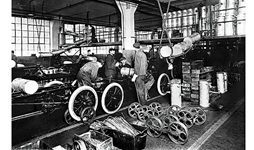 Karl Benz’s creation of the first motorcar in 1886 marked the beginning of the automotive industry. Henry Ford revolutionized production with the assembly line, making cars affordable for the masses. On January 29, 1886, Carl Benz applied for a patent for his “vehicle powered by a gas engine.” The patent – number 37435 – may be regarded as the birth certificate of the automobile.
Karl Benz’s creation of the first motorcar in 1886 marked the beginning of the automotive industry. Henry Ford revolutionized production with the assembly line, making cars affordable for the masses. On January 29, 1886, Carl Benz applied for a patent for his “vehicle powered by a gas engine.” The patent – number 37435 – may be regarded as the birth certificate of the automobile.
- Road Infrastructure
-
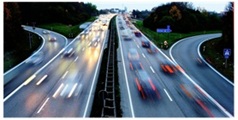 Governments invested heavily in road networks, including highways and bridges, to accommodate the rise in automobile use. The German Autobahn and U.S. Interstate Highway System are notable examples. The Autobahn is the federal controlled-access highway system in Germany.
Governments invested heavily in road networks, including highways and bridges, to accommodate the rise in automobile use. The German Autobahn and U.S. Interstate Highway System are notable examples. The Autobahn is the federal controlled-access highway system in Germany.
The Aviation Revolution
- Early Flights
-
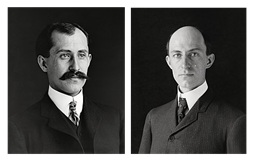 The Wright brothers achieved the first powered flight in 1903, heralding the aviation age. World War I and II accelerated advancements in aircraft technology. The Wright brothers, Orville Wright and Wilbur Wright, were American aviation pioneers generally credited with inventing, building, and flying the world's first successful airplane.
The Wright brothers achieved the first powered flight in 1903, heralding the aviation age. World War I and II accelerated advancements in aircraft technology. The Wright brothers, Orville Wright and Wilbur Wright, were American aviation pioneers generally credited with inventing, building, and flying the world's first successful airplane.
- Commercial Aviation
-
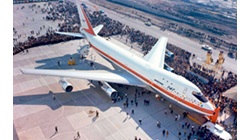 The mid-20th century saw the rise of commercial airlines, connecting continents and shrinking the world. Iconic aircraft like the Boeing 747 revolutionized air travel by making it accessible to millions. On September 30, 1968, the first 747 was rolled out of the custom-built Everett Plant, the world's largest building by volume.
The mid-20th century saw the rise of commercial airlines, connecting continents and shrinking the world. Iconic aircraft like the Boeing 747 revolutionized air travel by making it accessible to millions. On September 30, 1968, the first 747 was rolled out of the custom-built Everett Plant, the world's largest building by volume.
The Rise of Mass Transit Systems
- Trains and Subways
-
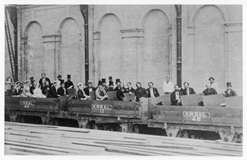 Subways and metro systems, such as the London Underground (1863), provided efficient urban transport solutions. High-speed trains like Japan’s Shinkansen and France’s TGV set new standards for rail travel. The London Underground has its origins in the Metropolitan Railroad, opening on January 10, 1863 as the world's first underground passenger rail network.
Subways and metro systems, such as the London Underground (1863), provided efficient urban transport solutions. High-speed trains like Japan’s Shinkansen and France’s TGV set new standards for rail travel. The London Underground has its origins in the Metropolitan Railroad, opening on January 10, 1863 as the world's first underground passenger rail network.
- Buses and Trams
- Public bus networks expanded in cities, offering affordable and flexible transport options. Electric trams became a staple of urban mobility in many European cities.
Modern Transport: Innovation and Sustainability
- Globalized Logistics
-
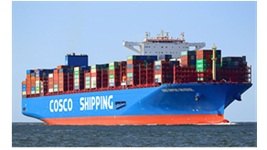 Containerization revolutionized shipping, streamlining global trade. Companies like DHL, FedEx, and Maersk dominate the logistics industry. Containerization is a system of intermodal freight transport using intermodal containers (also called shipping containers, or ISO containers).
Containerization revolutionized shipping, streamlining global trade. Companies like DHL, FedEx, and Maersk dominate the logistics industry. Containerization is a system of intermodal freight transport using intermodal containers (also called shipping containers, or ISO containers).
- Green Transport
-
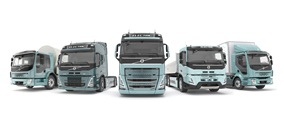 Electric vehicles (EVs), hydrogen-powered trains, and renewable energy solutions are shaping a sustainable future. Governments and companies are investing in reducing emissions and adopting cleaner technologies. Volvo electric truck range
Electric vehicles (EVs), hydrogen-powered trains, and renewable energy solutions are shaping a sustainable future. Governments and companies are investing in reducing emissions and adopting cleaner technologies. Volvo electric truck range
- Digital Transformation
- GPS, IoT, and AI are transforming logistics, making transport more efficient and reliable. Ride-sharing apps and autonomous vehicles are reshaping personal mobility.
The Future of Transport
- Hyperloop and Supersonic Travel
-
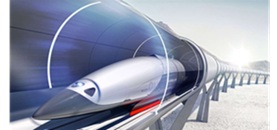 Hyperloop systems promise ultra-fast travel through vacuum tubes. Supersonic jets aim to revive faster-than-sound air travel for commercial use. Hyperloop is a proposed high-speed transportation system for both passengers and freight.
Hyperloop systems promise ultra-fast travel through vacuum tubes. Supersonic jets aim to revive faster-than-sound air travel for commercial use. Hyperloop is a proposed high-speed transportation system for both passengers and freight.
- Space Transport
-
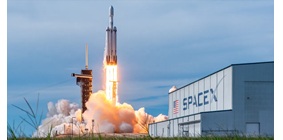 Companies like SpaceX and Blue Origin are exploring space tourism and interplanetary logistics. SpaceX, is an American space technology company headquartered at the Starbase development site near Brownsville, Texas.
Companies like SpaceX and Blue Origin are exploring space tourism and interplanetary logistics. SpaceX, is an American space technology company headquartered at the Starbase development site near Brownsville, Texas.
- Smart Cities and Mobility
-
 Integration of autonomous vehicles, smart traffic systems, and shared mobility will redefine urban transport. Smart cities: Cities using technological solutions to improve the management and efficiency of the urban environment.
Integration of autonomous vehicles, smart traffic systems, and shared mobility will redefine urban transport. Smart cities: Cities using technological solutions to improve the management and efficiency of the urban environment.
Conclusion
The history of transport is a testament to human innovation and adaptability. From primitive walking trails to space exploration, each milestone reflects humanity’s drive to connect, trade, and explore. As technology and sustainability shape the future, the transport sector will continue to evolve, bridging distances and enabling global progress.
eXus Dev